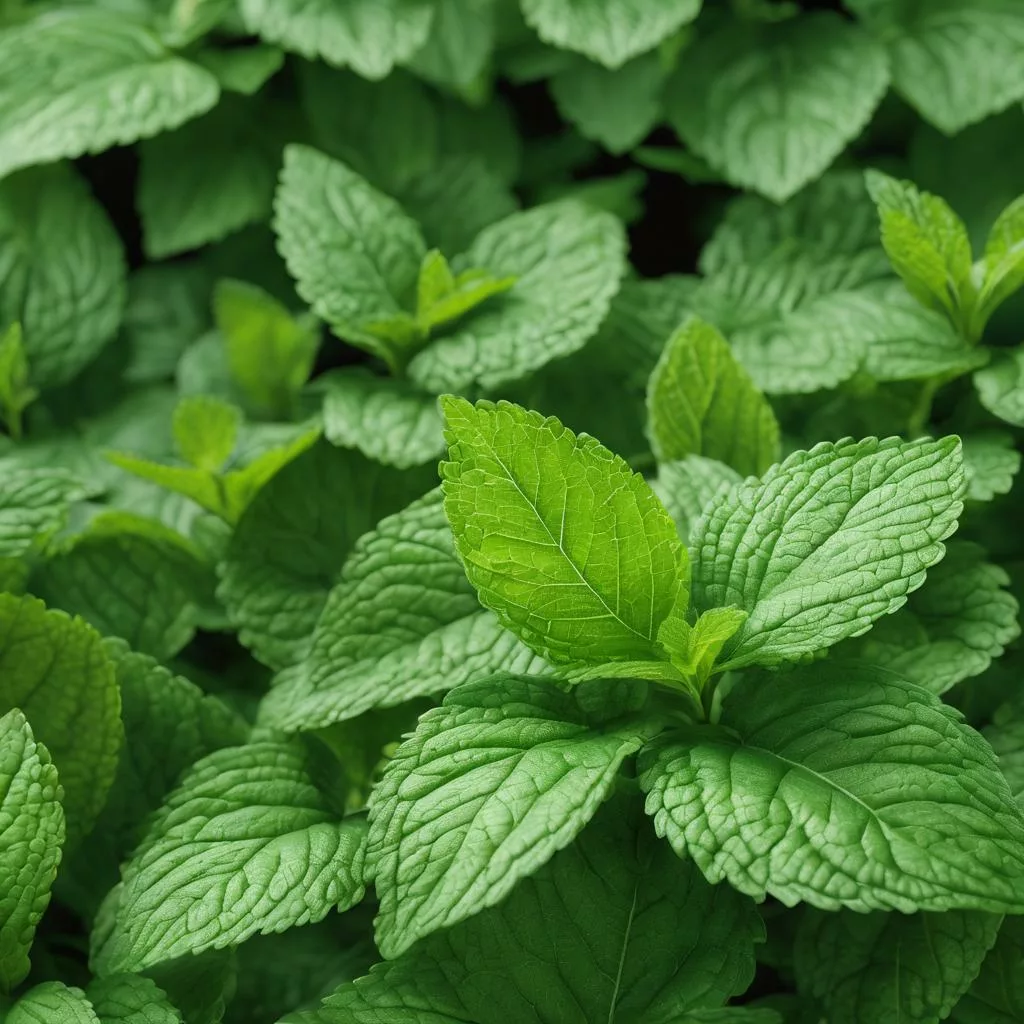
Mint and spearmint are often confused. Even though the majority of us are aware that both are members of the same botanical family, they have unique qualities that distinguish them from one another. The best way to comprehend this is to investigate the flavor profiles, culinary applications, health advantages, and even growing and harvesting advice for these adaptable herbs. Mint and spearmint both have distinctive flavors that can improve your culinary creations. In reality, the flavor of spearmint is refreshing, mildly sweet, and slightly earthy. However, a wider range of species are referred to as “mint,” including varieties like peppermint, apple, and chocolate. Mint typically has a stronger flavor profile than spearmint, with its distinctive coolness accompanied by hints of sweetness or spiciness, depending on the particular variety.
When used in cooking, both ingredients can be used in a wide range of dishes. Spearmint is frequently used in Mediterranean cooking to infuse salads, sauces, teas, and cocktails with a burst of freshness. Due to their potent flavor, mint varieties like peppermint are frequently used in sweets like ice cream or chocolates. For greater depth in dressings or marinades, both herbs can also be infused into oils or vinegars. Both are essential ingredients for any aspiring chef due to their versatility in cooking applications. You will be able to choose between spearmint and mint for your particular needs by being aware of their distinctive qualities and discovering how to use them in a variety of life contexts, from wellness to cooking. Let us set out on this tasty adventure together!
The Distinct Characteristics of Spearmint
You’ll notice that spearmint, with its cool and refreshing taste, has a subtle hint of sweetness that sets it apart from other mint varieties. The origins of spearmint can be traced back to ancient Greece and Rome, where it was highly valued for its medicinal properties. In fact, the name “spearmint comes from the pointed shape of its leaves, which resemble a spear. There are several different varieties of spearmint each with their own unique characteristics. One popular one is Moroccan spearmint, known for its strong aroma and flavor. It is often used in teas and culinary dishes for its refreshing taste. Another variety is apple mint, which has a slightly sweeter taste and is commonly used in desserts and cocktails.
Spearmint also holds cultural significance around the world. In Middle Eastern cuisine, it is commonly used in savory dishes such as lamb or yogurt-based sauces. In India, spearmint is associated with freshness and cleanliness and is often used in chutneys or added to drinks like lemonade. Spearmint stands out among other mint varieties due to its cool and refreshing taste with a subtle hint of sweetness. With different varieties available, such as Moroccan spearmint and apple mint, there are various options to explore when incorporating this versatile herb into culinary creations or traditional recipes from different cultures around the world.
Exploring the Broad Category of Mint
Allow your senses to be enticed by the energizing coolness and aromatic allure that this herbaceous wonder possesses as you explore the wide world of mint. There are numerous varieties in this diverse plant family, but the two most well-known are peppermint and spearmint. These two varieties of mint are distinguished from one another by distinctive qualities. Spearmint tastes sweeter and more delicately flavored than peppermint, which has a more potent menthol flavor and aroma. Mint variety history and folklore are both fascinating. Mint has been used for both culinary and medicinal purposes for ages. Mint was used in a number of rituals by the ancient Greeks and Romans, who thought it had magical properties. Additionally, it was frequently used as a breath freshener, digestive aid, and homeopathic treatment for conditions like headaches and indigestion. Worldwide, various cultures have developed distinctive customs involving mint.
After dinner, freshly brewed peppermint tea is traditionally served in England to promote digestion. In Middle Eastern countries like Morocco, mint leaves are often added to sweet teas or used in traditional dishes like tabbouleh salad. Additionally, mint is a crucial component of well-known cocktails like mojitos and juleps. You will learn that there are countless ways to use this herb in your daily life as you delve deeper into its world. It does not matter whether you prefer the strong flavor of peppermint or the delicate sweetness of spearmint—either variety adds a burst of freshness to any dish or beverage. So go ahead and give in to the allure of mint and let its refreshing coolness tantalize your taste buds!
Comparing the Taste Profiles
Exploring the world of mint reveals an intriguing contrast in flavor profiles, each of which offers a distinct sensory experience. Mint and spearmint differ in specific ways that make them stand out in terms of taste preferences. Spearmint is well known for its cooling, slightly sweet, and reviving flavor that is similar to gum or toothpaste. On the other hand, mint has a more potent flavor that is frequently described as soothing and cooling. Understanding the taste profiles of spearmint and mint is crucial for those who like herbal teas as much as I do in order to choose the flavor that best suits their tastes. Spearmint tea offers a delicate and pleasant taste that is both calming and invigorating.
If you are looking for a lighter and more delicate flavor in your tea, the sweetness gives any blend a touch of freshness. On the other hand, mint tea offers a strong flavor that can be quite energizing. When consumed after meals or on hot summer days, its potent menthol notes provide a cooling sensation in the mouth and throat. The tea is well-liked for its capacity to ease gastrointestinal discomfort and offer relief from motion sickness or indigestion. We find two distinct flavors that appeal to various tastes when we compare the taste profiles of the two herbs. While mint provides a stronger menthol kick, spearmint offers a sweet yet refreshing experience. Due to their distinctive qualities, which can enhance various blends depending on individual taste preferences, both are well-liked options for herbal teas.
Culinary Uses of Spearmint and Mint

Consider incorporating both spearmint and mint in your cooking if you want to give your dishes a burst of freshness. Despite the fact that both are frequently used interchangeably in cooking, they do have some distinctly different flavor profiles that can improve various dishes. Spearmint is a great addition to fruit salads, teas, and desserts because of its slightly sweeter flavor with citrus undertones. While mint pairs well with savory foods like lamb or as a garnish for cocktails, it has a stronger menthol flavor. When choosing which herb to use in your recipe, it is crucial to distinguish between spearmint and peppermint. While peppermint leaves are shorter and rounder, spearmint leaves are longer and pointier. Their flavor profiles are primarily different, with spearmint being sweeter and milder than peppermint’s brashness. Knowing the differences will enable you to select the ideal herb based on the flavor you want. There are countless possibilities for culinary inventions due to the distinctive flavor profiles of spearmint and mint.
The mild sweetness of spearmint pairs beautifully with fruits like strawberries or watermelon and gives summer salads or smoothies a cool twist. Due to its delicate nature, it is also the perfect ingredient to use when creating sauces or syrups for desserts like ice cream or chocolate mousse. In contrast, mint’s potent menthol punch makes it ideal for savory dishes like lamb kebabs with Middle Eastern influences or Vietnamese fresh spring rolls. With its strong flavor, you can make deliciously refreshing drinks like mojitos or herbal teas at home. Both herbs bring their own unique flavors to the table when it comes to culinary uses. Understanding the differences between these two herbs allows you to make informed decisions about which one best suits your dish’s needs. Incorporating spearmint or mint can enhance the flavors of your favorite recipes and add a burst of freshness to your culinary creations, whether you are going for a delicate sweetness or a strong menthol kick.
Health Benefits and Remedial Uses
Mint and spearmint have the potential to improve general wellbeing, according to research on their therapeutic and health benefits. These versatile herbs possess medicinal properties that have been utilized for centuries in various cultures around the world. Both spearmint and mint have essential oils that support their therapeutic effects, including menthol and rosmarinic acid. Spearmint is renowned for its ability to aid in digestion. It can lessen the discomfort of nausea, bloating, and indigestion. Because spearmint contains menthol, it naturally relaxes muscles and eases gastrointestinal discomfort. Additionally, this herb has antimicrobial qualities that can fight off harmful bacteria in the gastrointestinal tract. On the other hand, mint has many health advantages besides those related to digestion.
Its aroma has been demonstrated to have aromatherapy advantages on its own, encouraging relaxation and lowering stress levels. Mint tea or oil can be used topically to relieve headaches or migraines due to its cooling effect on the skin. Additionally, mint’s anti-inflammatory properties make it effective at treating respiratory diseases like bronchitis and asthma. Both mint and spearmint have a number of medicinal advantages that can enhance general health. These herbs are a great addition to any natural remedy toolbox because they can help with everything from digestion to treating respiratory issues or headaches. By incorporating them into your daily routine through teas, essential oils, or even just by chewing on fresh leaves, you can take advantage of their therapeutic properties and live a healthier lifestyle.
Read about the powerful benefits of black ginger.
Growing and Harvesting Spearmint and Mint
Growing and harvesting these adaptable herbs is as simple as 1-2-3 in terms of cultivation. Both are simple to grow indoors in pots or even in your backyard. Start by picking a sunny area with soil that drains well. While spearmint thrives in soil with a pH between 5.5 and 7.5, mint plants prefer slightly acidic soil with a pH between 6.0 and 7.0. Planting cuttings from an existing plant or starting from seeds are the two ways to grow mint or spearmint. If you decide to start with seeds, plant them in the ground as soon as your region’s last frost date has passed. Until the seedlings emerge, make sure the soil is moist. As an alternative, you can take cuttings from a mature plant by cutting a stem just below a set of leaves and soaking it in water until roots appear. Once your mint or spearmint plants are established, they require little maintenance, but because of their robust rhizome root systems, they do have a tendency to spread quickly. To best control their growth, grow them in containers or use barriers like plastic edging buried around the edge of your garden bed.
Both spearmint and mint leaves can be harvested at any time during the growing season once they are about 8 inches tall. Simply use clean pruning shears or scissors to remove individual leaves or cut entire stems close to the base. The leaves can be dried for later use by hanging them upside-down in bunches in a dim, well-ventilated area. They can also be used right away while still fresh. Both spearmint and mint possess medicinal properties that have been utilized for centuries across various cultures around the world. These herbs contain essential oils such as menthol, which provide numerous health benefits, including aiding digestion, soothing headaches, relieving congestion, and reducing inflammation. The aromatic compounds found in these herbs also have a calming effect on the nervous system, making them popular choices for herbal teas and aromatherapy. Furthermore, spearmint has been traditionally used to alleviate symptoms associated with hormonal imbalances such as menstrual cramps and menopausal hot flashes.
Choosing the Right Herb for Your Needs
After learning all there is to know about cultivating and gathering mint and spearmint, it is time to move on to the next aspect of these herbs: selecting the best one for your requirements. Both spearmint and mint have a variety of health advantages, but knowing how they differ will help you make a wise choice. Spearmint is well-known for its digestive properties when it comes to medicine. It has been used for a long time to relieve indigestion, soothe stomachaches, and lessen bloating. Carvone and limonene, two substances found in spearmint, have anti-inflammatory and antispasmodic properties that can soothe the digestive system. Mint, on the other hand, is well known for its capacity to relieve respiratory problems. Mint leaves contain menthol, which helps to open up airways, clear congestion, and relieve symptoms like coughing and wheezing.
Both are prized for their aromatic qualities in addition to their medicinal benefits. The energizing aroma of spearmint, which also has hints of sweetness, can improve your mood and promote clarity of thought. Aromatherapy frequently employs this plant’s aroma to treat fatigue or stress. The high menthol content of mint, on the other hand, gives it a stronger fragrance with cooling undertones. By promoting blood circulation, this energizing scent can help treat headaches and nausea. Depending on your unique requirements, you should decide between mint and spearmint. Spearmint might be a better choice for you if you need help with digestion or want a herb that encourages relaxation and mental clarity. On the other hand, if respiratory issues are a concern or if you seek an energizing aroma that provides headache relief, then mint would be more suitable. When making your decision, take into account both their medicinal and aromatic qualities—whichever you choose, these herbs will unquestionably improve your health in numerous ways!
Frequently Asked Questions
Can spearmint be used in cocktails or only in culinary dishes?
Yes, spearmint can be used in both culinary and cocktail recipes. Due to its cooling and slightly sweet flavor, spearmint is a common ingredient in cocktail recipes. It gives traditional drinks like mojitos and juleps a delightful twist by bursting with freshness and balancing the other ingredients. Spearmint is used in a variety of dishes in addition to cocktails. For an additional flavor layer, it can be added to salads, sauces, and marinades. Its vibrant green leaves are frequently used as a garnish or as an aromatic addition to syrups and teas. Therefore, spearmint is a versatile herb that will undoubtedly elevate your dishes and drinks with its distinctive flavor profile, whether you are looking to enhance your favorite cocktail or experiment with new culinary creations.
What are the different varieties of mint other than spearmint?
Mint comes in a variety of forms that can be used in a variety of dishes. One common type is peppermint, which has a potent and energizing flavor with hints of menthol and spearmint. Peppermint is frequently used in teas, cocktails, and desserts like ice cream and chocolate. The after-dinner mint, also referred to as chocolate mint or peppermint patty, is another variety. This variety of mint is excellent in baked goods like cookies and brownies because it has a deep chocolate flavor mixed with the zing of peppermint. There is also apple mint, which has a mildly fruity flavor and goes well with savory dishes such as salads, soups, and lamb recipes. The lemony flavor of lemon balm mint complements teas, sorbets, and fruit salads perfectly. The last option is ginger mint, which has a spicy kick and can be incorporated into Asian-inspired dishes or even cocktail syrups. You have a wide range of flavors to choose from when adding that fresh and aromatic touch to your favorite dishes, thanks to the various varieties of mint that are readily available for culinary use.
Are there any potential side effects or precautions to consider when using spearmint or mint?
As with any herbal remedy, there can be individual variations in how the body reacts, so it is important to keep this in mind when thinking about any possible side effects or precautions when using spearmint or mint. Mint and spearmint, when consumed in moderation, are typically safe for most people. Some potential side effects of consuming large amounts of spearmint or mint include gastrointestinal issues such as heartburn or acid reflux. Additionally, these herbs may cause allergic reactions in some people. It is also important to remember that using spearmint or mint could make symptoms of certain medical conditions worse, like GERD or issues with the gallbladder. It is always advisable to seek advice from a healthcare provider before incorporating any new herbs into your diet or way of life as a safety measure.
Can I grow spearmint and mint indoors, or do they require outdoor cultivation?
In response to your question about whether it is more successful to cultivate spearmint and mint indoors as opposed to outdoors, both plants can be grown successfully indoors. Actually, there are a number of benefits to cultivating spearmint and mint indoors. First of all, indoor cultivation provides better control over environmental factors that are crucial to the growth of these plants, such as temperature, humidity, and lighting. Growing herbs indoors allows you to have access to fresh herbs all year without being limited by the seasons. The risk of pests and diseases, which frequently affect outdoor crops, is reduced by indoor farming, which is another advantage. By creating a controlled environment free from outside threats, you can ensure the health and quality of your spearmint and mint plants.
Are there any alternative uses for spearmint or mint, such as in skincare products or home remedies?
Did you know that spearmint and mint can be used for purposes other than just flavoring food and beverages? These fragrant herbs are actually frequently used in aromatherapy and organic pest control. Due to its antiseptic and calming qualities, spearmint essential oil, which is extracted from the plant’s leaves, is frequently used in skincare products. It can treat acne, lessen inflammation, and even improve breath. On the other hand, mint is well known for its potent scent, which keeps pests like ants, spiders, and mice away. You can fend off pests without using dangerous chemicals by planting mint around your house or using mint oil as a natural repellent. Therefore, spearmint and mint offer a variety of additional uses beyond their culinary advantages, whether you are looking to improve your skincare routine or naturally ward off pesky insects.
Conclusion
When it comes to the conflict between spearmint and mint, both herbs have distinctive qualities that make them different. With its vivid green leaves and delicate aroma, spearmint has a cooling and slightly sweet flavor. However, the term “mint” covers a wider range of plants, each with a distinctive flavor, such as peppermint and wintergreen. In contrast to the bold and calming flavor offered by mint, spearmint is renowned for having a milder and less intense flavor. Because of this distinction, spearmint is a fantastic option for people who prefer a delicate undertone of freshness in their culinary endeavors. On the other hand, mint is ideal for people seeking a stronger and more energizing flavor experience.
Both have many uses in the culinary arts, where they give dishes depth and vibrancy. These herbs add to the overall flavor profile of everything from salads to cocktails while also adding their distinctive fragrance. Due to their antioxidant qualities and potential medicinal uses for easing digestive problems or soothing sore throats, they also provide a wealth of health advantages. It is crucial to remember that spearmint tends to be harder than most types of mint for those interested in growing these herbs at home. It grows well in sunny areas with well-draining soil, but if it is not properly contained, it can quickly spread. Different varieties of mint, however, might have unique needs with regard to soil pH levels or sunlight exposure. Ultimately, whether you choose mint or spearmint depends on your preferences and intended uses. Whether you choose the boldness of different mint varieties or the boldness of spearmint, incorporating these aromatic herbs into your life will undoubtedly improve your sensory experience as a whole. Keep in mind that sometimes making decisions in life is like choosing between two delicious flavors.

